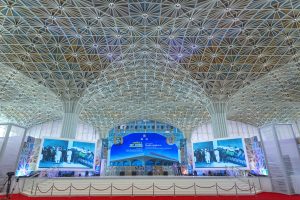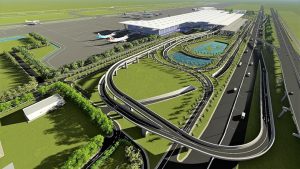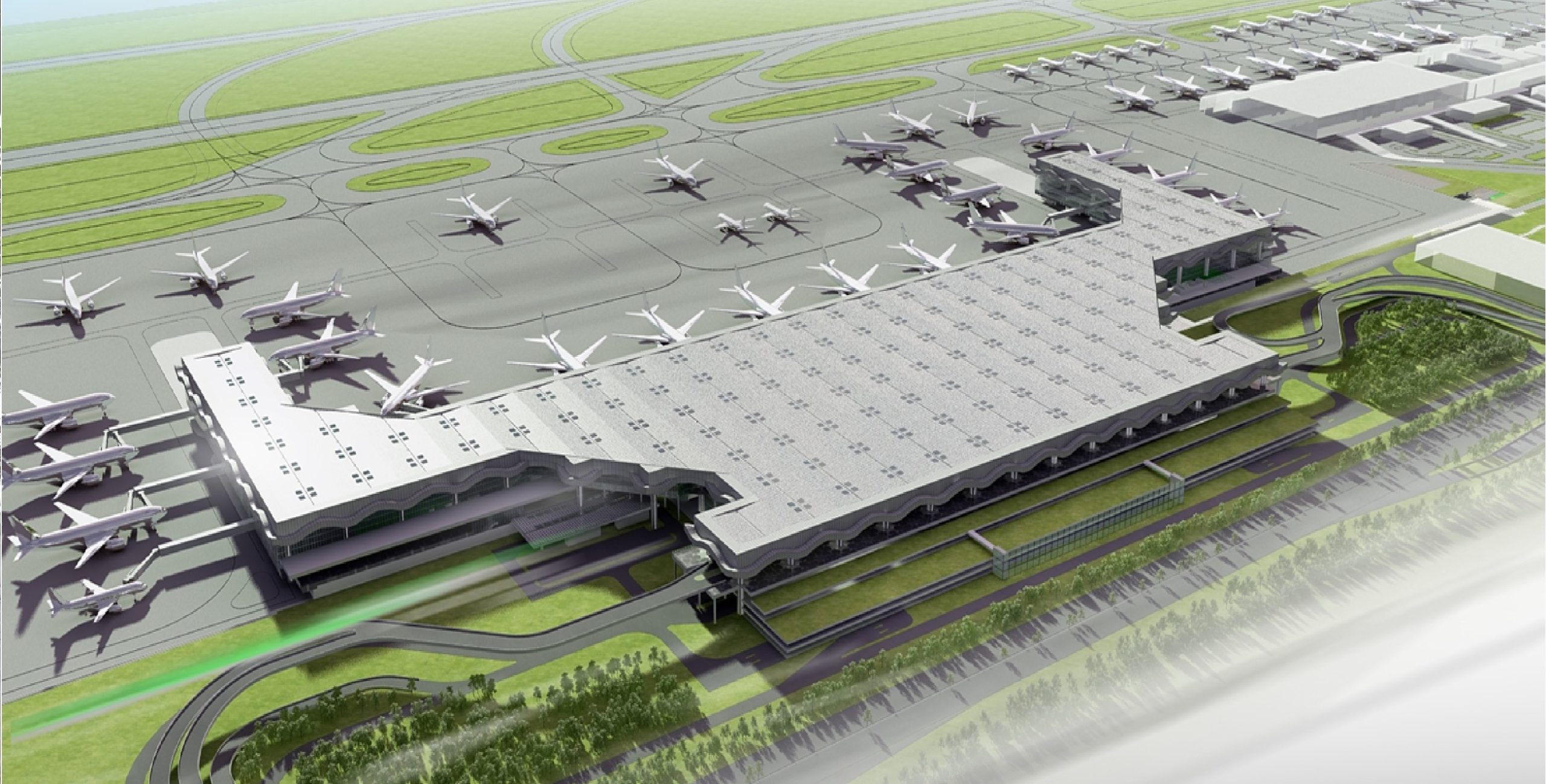In a historic moment for Bangladesh’s aviation sector, Prime Minister Sheikh Hasina officially inaugurated the much-anticipated third terminal at Hazrat Shahjalal International Airport (HSIA) today, marking a new era for air travel in the country. With the theme “Connecting Dreams to Reality,” the opening ceremony was attended by high-ranking government officials, dignitaries, and aviation experts, reflecting the significance of this milestone.
The third terminal, covering a vast area of 542,000 square meters, boasts a floor space of 230,000 square meters, housing 115 check-in counters, 66 departure immigration desks, 59 arrival immigration counters, and 3 VIP immigration desks. The terminal’s design is not only visually appealing but also aligned with modern global standards.
During the inauguration ceremony, Prime Minister Sheikh Hasina was joined by notable figures, including Vice-Minister for Foreign Affairs of Japan Masahiro Komura, State Minister for Civil Aviation and Tourism Mahbub Ali, Civil Aviation and Tourism Secretary Mokammel Hossain, and Civil Aviation Authority of Bangladesh (CAAB) Chairman Air Vice Marshal M Mafidur Rahman. Japan’s Minister of Land, Infrastructure, Transport, and Tourism, Saito Tetsuo, was also present, reflecting the strong collaboration between the two nations in making this project a reality.

The dream of constructing the iconic third terminal at HSIA, which began in December 2019, has now become a reality. The prime minister inaugurated the terminal with great enthusiasm, walking through the newly built facility and closely inspecting its state-of-the-art amenities. The story of the third terminal at Hazrat Shahjalal International Airport (HSIA) in Dhaka began with a pivotal feasibility study conducted by the Civil Aviation Authority of Bangladesh (CAAB) in 2014. At that time, the airport had a passenger handling capacity of 8 million annually. However, with the burgeoning growth of Bangladesh’s aviation sector, the demand for air travel was on a remarkable upward trajectory. According to the study, annual passenger traffic was projected to surge to 140 million by 2025 and a staggering 250 million by 2035, far exceeding the airport’s capacity.
To address this impending challenge, CAAB sought collaboration with the Japan International Cooperation Agency (JICA), a prominent Japanese donor known for its support of infrastructure development projects in numerous countries. In 2016, JICA conducted a comprehensive financial and economic evaluation in conjunction with CAAB’s feasibility test. The results were nothing short of remarkable and this analysis not only solidified the project’s viability but also underscored its robust economic potential.
The construction of the third terminal at HSIA began in 2019, with generous funding from both the Bangladesh Government and JICA, ultimately resulting in a total project cost of Tk 21,300 crore. On 28th December 2019, Prime Minister Sheikh Hasina inaugurated the eagerly anticipated construction of the ‘Third Terminal’ at Hazrat Shahjalal International Airport (HSIA). The prime minister formally initiated the construction work by laying the foundation stone during the ceremony. Alongside this pivotal event, she had also unveiled two new Dreamliner aircraft, Boeing 787-9, for Bangladesh Biman, named ‘Sonar Tori’ and ‘Achin Pakhi.’ Additionally, on the sidelines of the ceremony, the prime minister had inaugurated a new mobile app for the national flag carrier.

The significance of this ambitious project became evident as it aimed to construct a three-story terminal covering a vast area of 542,000 square meters. The terminal’s design promised to serve 12 million passengers annually, with extensive aircraft parking facilities accommodating 37 aircraft in an area of 230,000 square meters. The terminal was equipped with numerous passenger-friendly amenities, such as check-in counters, immigration desks, baggage screening machines, body scanners, security screening points, boarding bridges, and luggage belts, aligning it with international standards and quality of service.
This monumental project, beyond its architectural grandeur, has far-reaching economic implications for Bangladesh. Shahjalal International Airport’s existing two international terminals, with a combined annual passenger handling capacity of 8 million, were already straining to manage the 70 lakh passengers they received each year. The statistics from JICA’s forecast painted a future of extraordinary growth, with annual passenger demand expected to surpass 160 million by 2025 and a staggering 230 million by 2030.
Recognizing the logistical impossibility of building a new airport in Dhaka due to space constraints and the extensive time and capital such a project would require, the decision to expand the existing airport and build a new terminal was made. The third terminal project is poised to significantly enhance the airport’s passenger handling capacity, accommodating over two crores of passengers annually and driving up revenue per passenger. Moreover, the terminal’s role in cargo handling is equally pivotal.
The new terminal, equipped with modern facilities, including separate cargo villages for import and export, holds the promise of streamlining the import-export process, reducing delays, and improving cargo handling efficiency. With air-conditioned warehouses and modern equipment, perishable goods can be stored without deterioration, presenting a boost to the country’s foreign trade. This project stands to benefit not only passengers but also the nation’s economy as it ushers in a new era for Bangladesh’s aviation sector.
The third terminal project, with a total cost of Tk 21,300 crore, began on December 28, 2019. The government of Bangladesh contributed Tk 5,000 crore, while the Japan International Cooperation Agency (JICA) provided the remaining funding. This collaboration underscores the mutual commitment to enhancing Bangladesh’s aviation infrastructure.
The terminal is expected to double Dhaka Airport’s annual passenger and cargo handling capacity, transforming it into a significant regional aviation hub. The annual passenger handling capacity, including the old terminals, will increase to 24 million from the current 8 million, and the airport will be able to handle 500,000 tonnes of cargo annually.
 The third terminal sets new benchmarks for passenger comfort and convenience. It features 27 baggage x-ray screener machines, 11 body scanners, 25 central departure security screening points, 16 boarding bridges, and 16 luggage belts, ensuring a swift and efficient flow of passengers and baggage. Moreover, passengers will benefit from 14 moving walkways, a first for any airport in Bangladesh, offering added convenience, particularly for the elderly and families.
The third terminal sets new benchmarks for passenger comfort and convenience. It features 27 baggage x-ray screener machines, 11 body scanners, 25 central departure security screening points, 16 boarding bridges, and 16 luggage belts, ensuring a swift and efficient flow of passengers and baggage. Moreover, passengers will benefit from 14 moving walkways, a first for any airport in Bangladesh, offering added convenience, particularly for the elderly and families.
The export and import cargo complex, fully automated, will streamline the cargo handling process, offering an annual capacity of 273,470 tons and 546,941 tons, respectively. The introduction of modern equipment is expected to expedite goods clearance in import-export, reducing delays and enhancing efficiency. The third terminal is poised to redefine the passenger experience at Dhaka Airport. With world-class facilities, including high-quality restaurants, shopping malls, super shops, luxury cafes, and bars, passengers can enjoy a level of service comparable to major international airports such as London Heathrow and Changi Airport in Singapore. These facilities will not only enhance the travel experience but also contribute to the airport’s revenue generation.
The terminal is directly connected to the rail network via individual subway stations, providing passengers with easy access to the airport via Metrorail and other transportation modes. The availability of an elevated expressway and a Bus Rapid Transit (BRT) system further ensures seamless connectivity and accessibility to and from the airport. The opening of the new terminal will have a profound economic impact on Bangladesh. It is expected to increase the airport’s annual passenger handling capacity from 8 million to over 20 million, while cargo capacity will expand from 200,000 tons to 500,000 tons. This growth is projected to drive revenue per passenger and significantly contribute to the country’s trade and commerce.
The construction of the third terminal, in parallel with other expansion works, is set to facilitate an increase in the number of flights and airlines operating from Dhaka Airport. Several foreign airlines have already expressed interest in launching operations from the newly upgraded facility. This is expected to boost the country’s aviation sector and contribute to its economic growth.

The construction of the third terminal was not without its share of challenges. Engineers working on the project faced numerous obstacles, but their innovative solutions and determination enabled the successful completion of the terminal. From the use of modern technologies to cost-saving design changes, the project demonstrates the resilience and commitment of all involved. For instance, the decision to adopt a conventional piling method in lieu of screw piling, which had failed in another project, saved Tk 700 crore. Additionally, extensive coordination was required to relocate utility services, ensuring a smooth construction process.
The third terminal at Hazrat Shahjalal International Airport represents a significant leap forward for Bangladesh’s aviation sector. Its modern facilities, improved efficiency, and seamless connectivity will not only elevate the passenger experience but also drive economic growth, making Bangladesh a more attractive destination for travelers and businesses alike.
As the country takes its place on the global stage, the new terminal is a testament to Bangladesh’s commitment to progress and innovation. With this transformative project, the nation is better positioned than ever to play a pivotal role in shaping the impressions of visitors, and as the saying goes, “first impressions are often the most enduring.” Dhaka Airport’s third terminal is set to leave a lasting and positive impression on all who pass through its doors.
Written by-
Air Vice Marshal M Mafidur Rahman
BBP,BSP,BUP,ndu, afwc,psc
Chairman
Civil Aviation Authority of Bangladesh


